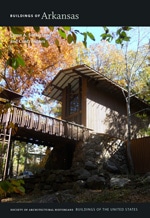The creation of Greer’s Ferry Lake around 1966 resulted in increased tourist traffic and population growth for Heber Springs. Bob Shaheen and Pat Goodfellow, landscape architects with whom architect Jones had worked previously, were interested in building a weekend cottage beside the newly developed lake. Two architectural challenges Jones enjoyed were designing for dramatic sites and the requirements of low-cost building, and both are evident here. The small house rises from a foundation of local granite, which encloses the lowest level of living space, with extra sleeping space and a grotto-like shower and bathroom, both of which are provided with daylight and ventilation by sloping skylights at the upper level of the foundation walls. The simple frame structure of the main floor is the forerunner of the structural system Jones employed in Thorncrown Chapel (CR17) in Eureka Springs, and the chapel’s dimensions are exactly double those of this cottage. The cottage is twice as high as it is wide. Its second level, with living and dining rooms and kitchen, extends to form an outdoor deck. Light enters the rooms from a high band of windows at the top of the side walls under the wide overhanging eaves. A helical stairway is the only vertical circulation between the lower level and the main level, and a ladder gives access to a sleeping deck midway between the main floors and the raftered ceiling. Ownership of the cottage has changed a number of times, and it is currently available for vacation rental.
You are here
Stoneflower (Shaheen-Goodfellow Weekend Cottage)
If SAH Archipedia has been useful to you, please consider supporting it.
SAH Archipedia tells the story of the United States through its buildings, landscapes, and cities. This freely available resource empowers the public with authoritative knowledge that deepens their understanding and appreciation of the built environment. But the Society of Architectural Historians, which created SAH Archipedia with University of Virginia Press, needs your support to maintain the high-caliber research, writing, photography, cartography, editing, design, and programming that make SAH Archipedia a trusted online resource available to all who value the history of place, heritage tourism, and learning.















